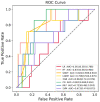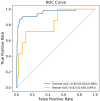Development and Evaluation of a Machine Learning Prediction Model for Small-for-Gestational-Age Births in Women Exposed to Radiation before Pregnancy
- PMID: 35455666
- PMCID: PMC9031835
- DOI: 10.3390/jpm12040550
Development and Evaluation of a Machine Learning Prediction Model for Small-for-Gestational-Age Births in Women Exposed to Radiation before Pregnancy
Abstract
Exposure to radiation has been associated with increased risk of delivering small-for-gestational-age (SGA) newborns. There are no tools to predict SGA newborns in pregnant women exposed to radiation before pregnancy. Here, we aimed to develop an array of machine learning (ML) models to predict SGA newborns in women exposed to radiation before pregnancy. Patients' data was obtained from the National Free Preconception Health Examination Project from 2010 to 2012. The data were randomly divided into a training dataset (n = 364) and a testing dataset (n = 91). Eight various ML models were compared for solving the binary classification of SGA prediction, followed by a post hoc explainability based on the SHAP model to identify and interpret the most important features that contribute to the prediction outcome. A total of 455 newborns were included, with the occurrence of 60 SGA births (13.2%). Overall, the model obtained by extreme gradient boosting (XGBoost) achieved the highest area under the receiver-operating-characteristic curve (AUC) in the testing set (0.844, 95% confidence interval (CI): 0.713-0.974). All models showed satisfied AUCs, except for the logistic regression model (AUC: 0.561, 95% CI: 0.355-0.768). After feature selection by recursive feature elimination (RFE), 15 features were included in the final prediction model using the XGBoost algorithm, with an AUC of 0.821 (95% CI: 0.650-0.993). ML algorithms can generate robust models to predict SGA newborns in pregnant women exposed to radiation before pregnancy, which may thus be used as a prediction tool for SGA newborns in high-risk pregnant women.
Keywords: exposure to radiation; machine learning; prediction; small for gestational age.
Conflict of interest statement
The authors declare no conflict of interest.
Figures





Similar articles
-
Development and evaluation of machine learning models for predicting large-for-gestational-age newborns in women exposed to radiation prior to pregnancy.BMC Med Inform Decis Mak. 2024 Jun 20;24(1):174. doi: 10.1186/s12911-024-02556-6. BMC Med Inform Decis Mak. 2024. PMID: 38902714 Free PMC article.
-
Predictive models for small-for-gestational-age births in women exposed to pesticides before pregnancy based on multiple machine learning algorithms.Front Public Health. 2022 Aug 8;10:940182. doi: 10.3389/fpubh.2022.940182. eCollection 2022. Front Public Health. 2022. PMID: 36003638 Free PMC article.
-
Comprehensive assessment of the genetic characteristics of small for gestational age newborns in NICU: from diagnosis of genetic disorders to prediction of prognosis.Genome Med. 2023 Dec 13;15(1):112. doi: 10.1186/s13073-023-01268-2. Genome Med. 2023. PMID: 38093364 Free PMC article.
-
Machine learning risk score for prediction of gestational diabetes in early pregnancy in Tianjin, China.Diabetes Metab Res Rev. 2021 Jul;37(5):e3397. doi: 10.1002/dmrr.3397. Epub 2020 Sep 9. Diabetes Metab Res Rev. 2021. PMID: 32845061
-
[Development and evaluation of a machine learning prediction model for large for gestational age].Zhonghua Liu Xing Bing Xue Za Zhi. 2021 Dec 10;42(12):2143-2148. doi: 10.3760/cma.j.cn112338-20210824-00677. Zhonghua Liu Xing Bing Xue Za Zhi. 2021. PMID: 34954978 Chinese.
Cited by
-
Post-natal gestational age assessment using targeted metabolites of neonatal heel prick and umbilical cord blood: A GARBH-Ini cohort study from North India.J Glob Health. 2024 Jul 5;14:04115. doi: 10.7189/jogh.14.04115. J Glob Health. 2024. PMID: 38968007 Free PMC article.
-
Development and evaluation of machine learning models for predicting large-for-gestational-age newborns in women exposed to radiation prior to pregnancy.BMC Med Inform Decis Mak. 2024 Jun 20;24(1):174. doi: 10.1186/s12911-024-02556-6. BMC Med Inform Decis Mak. 2024. PMID: 38902714 Free PMC article.
-
Prediction of Hemorrhagic Complication after Thrombolytic Therapy Based on Multimodal Data from Multiple Centers: An Approach to Machine Learning and System Implementation.J Pers Med. 2022 Dec 12;12(12):2052. doi: 10.3390/jpm12122052. J Pers Med. 2022. PMID: 36556272 Free PMC article.
References
LinkOut - more resources
Full Text Sources

